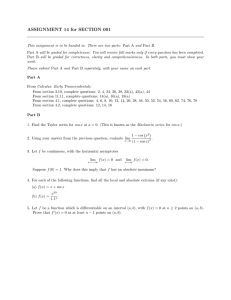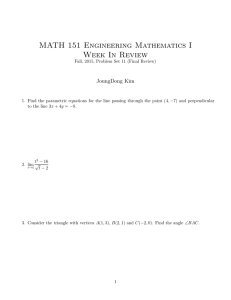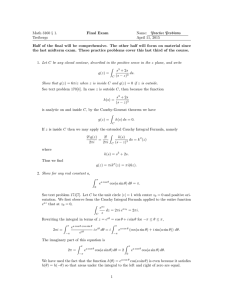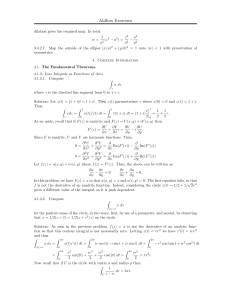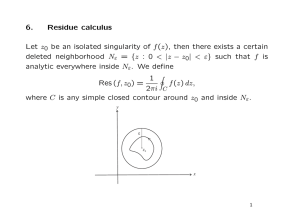Solutions to MATH 300 Homework 8 EXERCISES 5.3
advertisement
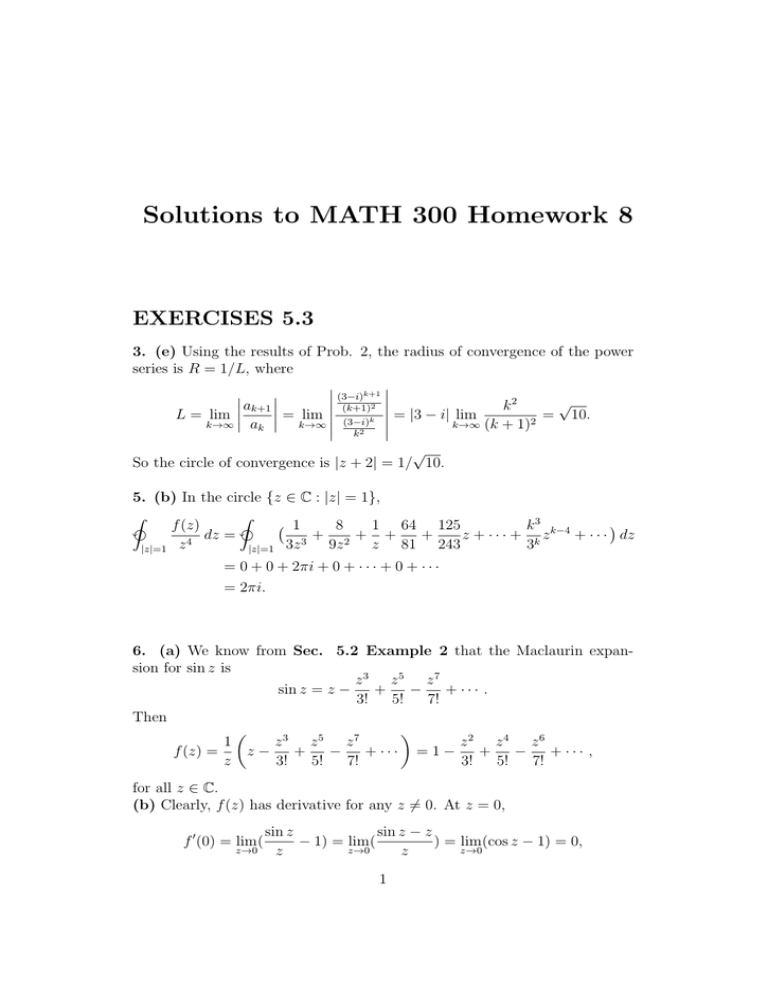
Solutions to MATH 300 Homework 8
EXERCISES 5.3
3. (e) Using the results of Prob. 2, the radius of convergence of the power
series is R = 1/L, where
(3−i)k+1 √
ak+1 k2
= lim (k+1)k2 = |3 − i| lim
=
10.
L = lim 2
k→∞ (3−i) k→∞ (k + 1)
k→∞
ak
2
k
√
So the circle of convergence is |z + 2| = 1/ 10.
5. (b) In the circle {z ∈ C : |z| = 1},
ffi
ffi
f (z)
1
8
1 64 125
k 3 k−4
dz
=
+
+
+
+
z
+
·
·
·
+
z
+
·
·
·
dz
4
3
9z 2 z 81 243
3k
|z|=1 3z
|z|=1 z
= 0 + 0 + 2πi + 0 + · · · + 0 + · · ·
= 2πi.
6. (a) We know from Sec. 5.2 Example 2 that the Maclaurin expansion for sin z is
z3 z5 z7
sin z = z −
+
−
+ ··· .
3!
5!
7!
Then
1
z3 z5 z7
z2 z4 z6
f (z) =
z−
+
−
+ ··· = 1 −
+
−
+ ··· ,
z
3!
5!
7!
3!
5!
7!
for all z ∈ C.
(b) Clearly, f (z) has derivative for any z 6= 0. At z = 0,
f 0 (0) = lim(
z→0
sin z
sin z − z
− 1) = lim(
) = lim(cos z − 1) = 0,
z→0
z→0
z
z
1
where the 3rd equality results from Maclaurin expansion of sin z and cos z at
z = 0. Therefore, f has derivative in a neighbourhood of the origin, hence is
analytic there.
(c) f (3) (0) = 3!a3 = 0.
(d) f (4) (0) = 4!a4 = 4!(1/5!) = 1/5.
ak
kak
10. Applying Prob. 2, limk→∞ | ak+1
| = R = limk→∞ | (k+1)a
|.
k+1
EXERCISES 5.5
√
2. (b) No. Recall that the principal branch of z is analytic in the slit domain D∗ = C\(−∞, 0]. Thus, the condition of Theorem 14 does not satisfy.
3. (b)
∞
∞
1
1
1
1
1X
1X 1 j j
j−1 −j
−
f (z) =
=
(−1) z −
( )z .
3z 1 − (− z1 )
3 1 − z2
3 j=1
3 j=0 2
6. As we already know,
cos w =
∞
X
(−1)j
j=0
w2j
,
(2j)!
1
for all (finite) w. Therefore, the Laurent series for z 2 cos( 3z
) is
∞
2−2j
X
j z
.
(−1) 2j
3 (2j)!
j=0
7. (b) As we know,
z
e =
∞
X
zk
k=0
k!
.
Then
1
1
= P∞
z
e −1
k=1
where
(
∞
X
j=0
∞
zk
k!
aj z j )
1
1
1X
= P∞ zk−1 :=
aj z j ,
z k=1 k!
z j=0
1
P∞
z k−1
k=1 k!
2
!
= 1.
Therefore, comparing the coefficients gives us
1
1
1
a0 = 1, a1 + a0 = 0, a2 + a1 + a0 = 0, · · ·
2
2
6
Then
1
1
a0 = 1, a1 = − , a2 = , · · ·
2
12
9. Consider the cases j > 0 and j < 0. Then the series can be written as
∞
∞ ∞
X
X
zj
z j X 1
=
+
.
2|j|
2
(2z)j
j=−∞
j=0
j=1
1
< 1 and
Then
in
order
that
these
geometric
series
converge,
we
need
2z
z
< 1, whence 1 < |z| < 2.
2
2
3






